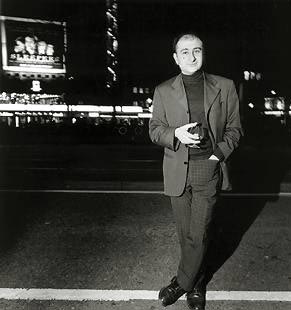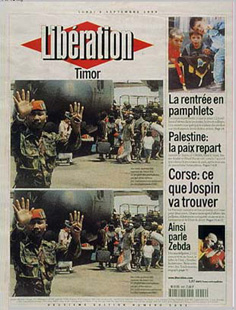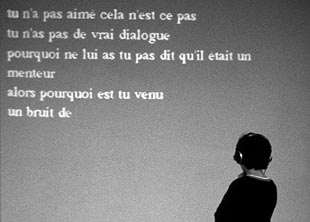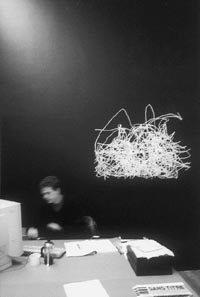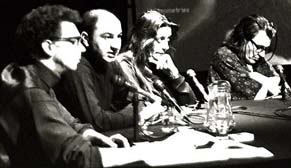–––––01 | –––––02 | –––––03 |–––––03bis | –––––04 |–––––05 |–––––06 |–––––07 | –––––Annexes |–––––Biennale de venise 2001 |–––––Manifesta 4| ––––––––––––––––––––––––––––––––––––––––––––––––––Annexes Pierre Bismuth |
|||||||||||||||||
| Pierre Bismuth on line |
|||||||||||||||||
|
|||||||||||||||||
La galerie de Pierre Bismuth: LISSON GALLERY à Londres • http://www.lisson.co.uk |
|||||||||||||||||
| Chronologie partielle des expositions | |||||||||||||||||
| • 2001 —18 mars -5 mai 2001 • Centre d'art contemporain de Brétigny Espace Jules Verne, rue Henri-Douard, Brétigny-sur-Orge (91). 01 60 85 20 85. Du mardi au samedi de 14h à 18h, mer également de 10h à midi et sam de 11h à 13h, entrée libre. Thème : Installation : Plusieurs pièces très récentes, réalisées notamment à l'occasion de sa dernière exposition au Centre d'art contemporain de Vilnius en Lituanie et d'autres réalisées spécialement pour le Centre d'art contemporain de Brétigny. Deux pièces seront spécialement réalisées par Pierre Bismuth en collaboration avec Jonathan Monk et Angus Fairhurhst. —juin 1999 • Musée d'art moderne et contemporain de Genève Mamco >>>> www.mamco.ch |
|||||||||||||||||
|
|
|||||||||||||||||
• 2000 — Friday 8 December 2000 • Angust FAIRHURST in conversation with Pierre BISMUTH Angus Fairhurst creates work in many media which often transforms the familiar and disturbing linear narrative - what you see is not necessarily what you get. In conversation with London-based artist Pierre Bismuth, Fairhurst will discuss his working methods and, in particular, his work in ‘Apocalypse’. Venue: Royal Academy. Time: 6.30pm-7.30pm. £10/£7 students (includes a drink and exhibition). — September 2 - October 31 2000, Contemporary Art and Technology Biennial, Seoul, Korea IN PREVENTION OF TECHNICAL MALFUNCTION, 2000 (Unplugged Douglas Gordon's Work) One channel video with one monitor, unplugged. Collection of the artist and Lisson Gallery, London media_city seoul is an international biennial event on view in museums and public venues throughout Seoulthat presents and explores the convergence of technology and the contemporary arts. The theme for the inaugural biennial, city: between and 1, interprets the ways in which the digital revolution is transcending physical boundaries of space and time. Artists: Including Vito Acconci, PilYun Ahn, Chantal Akerman, Laurie Anderson, Matthew Barney, Pierre Bismuth, Christian Boltanski, Stan Douglas, Douglas Gordon, Dan Graham, Zaha Hadid, Bernd Halbherr, Gary Hill, Myungseop Hong, Michel Jaffrennou, Haemin Kim, Kichul Kim, Sora Kim, Alexander Kluge, Rem Koolhaas, Bul Lee, Sookyung Lee, Steve McQueen, Tony Oursler, Nam June Paik, Pipilotti Rist, Danny Rozin, Ilgon Song, SUPARTIST, Rosemarie Trockel, Bill Viola, Tamas Waliczky, Jane & Louise Wilson, HyunJung Yu and Pei Li Zhang. General/Artistic Director: Misook Song, Art Historian and Critic Curators: Barbara London, The Museum of Modern Art, New York; Jeremy Millar, Artist and Curator, London; Hans Ulrich Obrist, Le Musée d1Art Moderne de la Ville de Paris; Byoung Hak Ryu, Independent Curator; Shin Eui Park, Art Historian and Critic; and, Chang Ik Jang, Magic I Entertainment Co. Ltd. Organizers: media_city seoul 2000 Organizing Committee Sponsors: Seoul Metropolitan Government Seoul Industry Promotion Foundation — 15 septembre 2000 ALTERNANCE D'ÉCLAIRCIES ET DE PASSAGES NUAGEUX L'APRÈS-MIDI, 1999 (60 petits films)Lausanne jardins 2000 • http://www.athenaeum.ch/galerie5.htm 22 h Projections en plein air, Grand écran d'Espace Flon. — july 2000. -September 2000 • Lisson Gallery http://www.lisson.co.uk |
|||||||||||||||||
• 1999 POSTSCRIPT/THE PASSENGER, 1996 • LINK, 1999 • Cinéma Cinéma - Contemporary Art and the Cinematic Experience Rooms 8 and 14 • |
|||||||||||||||||
|
|||||||||||||||||
| http://www.vanabbemuseum.nl For POSTSCRIPT/THE PASSENGER (1996) the French artist Pierre BISMUTH asked a typist to write a description of the soundtrack of Michelangelo Antonioni's film Professione: Reporter, which she had not seen. Bismuth told her to describe what she heard as fully and accurately as possible. In this work we see the letters she types projected onto the wall. She has to let the soundtrack run without stopping it, and so she is forced t interpret various unfamiliar sounds and to choose what to write down. The spectator sees this happening. Sometimes whole sentences are removed and replaced by a new interpretation of the sounds. The original sound track can be heard through headphones. Bismuth strips the film of its most important feature: the image. He replaces it by text. He is principally interested in how the human brain processes and interprets sound, image and text. Pierre Bismuth travaille sur "cette idée fausse qui consiste à croire qu'on est réellement en face des choses, supposé pouvoir choisir, qu'on a une identité hypersolide". Et ses oeuvres sont comme des tentatives de saisir l'individu en cours de création: comment il se constitue, se construit à chaque seconde, comment il réagit au monde. Et surtout comment il échappe constamment à lui–même... |
|||||||||||||||||
LINK (1999) is a work in progress. A monitor shows the film Sleuth (1972) by Joseph Manckiewicz. Each time another camera angle is chosen in the film, the space in which the monitor stands changes too. MICRO/MACRO, 1999, installation http://www.centreimage.ch/02progF/expos/1999/expos_bim8_f.html Pierre BISMUTH présente une installation sonore sans image créée spécialement pour la Biennale. Bismuth casse les liens, nos habitudes perceptives. Des micros, placés dans différents lieux visibles depuis les fenêtres du deuxième étage du Centre pour l'image contemporaine, offriront des sons de la ville amplifiés et en total décalage de situation.Comme il le dit dans sa lettre du 12 juillet dernier adressée à Simon Lamunière, Bismuth aimerait "amener les gens à passer du temps devant la fenêtre et à chercher les points de correspondance entre ce qui est donné à entendre et le spectacle de la rue". 28 mai 1999 • Centre national de la photographie, Paris: "Dans l'ensemble de son travail Pierre Bismuth décompose les éléments de perception d'un événement, d'une image, d'un son etc. Il observe comment, d'une situation initiale à sa réception, le sens de cette situation se déplace, et montre ainsi des intervalles, des hiatus, des distorsions. Les recherches de Pierre Bismuth couvrent un champ élargi de matières et de formes possibles et se concentrent sur les mécanismes de compréhension, de subjectivité et d'appropriation du spectateur". |
|||||||||||||||||
• 1998 DOORS OF PERCEPTION 5: PLAY • http://www.ifthen.org/description.html 264-page journal launches at DOORS OF PERCEPTION 5: PLAY, featuring over 40 writers, designers, artists, computer pioneers, novelists and photographers, including PAUL AUSTER, PIERRE BISMUTH, RINEKE DIJKSTRA, J.C. HERZ, ANDREAS GURSKY, ALAN KAY , ANDREA MOED, HELEN LEVITT, MALCOLM MCCULLOUGH, MITCHEL RESNICK and URI TZAIG. Published by the Netherlands Design Institute IF/THEN (www.ifthen.org) is a new journal that investigates the design implications of new media technologies, as expressed in everyday material culture. It offers an advance radar on the ideas generated by the Institute, whose main mission is to explore the role of design in various social, economic, demographic and technological scenarios. An agenda-setting critical review, developed in planned relationship to the Institute's knowledge-gathering events, IF/THEN is edited by Janet Abrams, assistant editor Julia van Mourik, and designed by Mevis & Van Deursen of Amsterdam. Published in English, it is aimed at an international audience of designers in graphics, new media, product design and information design, as well as those business executives, policy makers, academics and media professionals who have enjoyed the mingling of minds at the Institute's flagship event, the DOORS OF PERCEPTION conference www.doorsofperception.com. IF/THEN 0.1 includes a major report on the European Union's 'i3' programme, to develop new paradigms for 'intelligent information interfaces' as well as reports on the NetherlandDesign Institute's 1998 Getting On! series (on the efflorescence of interfaces from the body to the city) and its Knowledge Maps seminar (on interface design for knowledge management). The largest section of IF/THEN 0.1 is devoted to PLAY, coinciding with the theme of the fifth DOORS OF PERCEPTION conference, including: Paul Auster's memoir 'Action Baseball', Alan Kay on new media from clavichords to computer keyboards; Janet Abrams on the brains behind LEGO's new electronic 'Bricks with Brains'; Matilda Blyth's profile of Iona Opie, anthropologist of school children's playground behaviour, Ine Poppe on interaction designers Ijsfontein, Pauline Bax's account of babysitting a Baby Think It Over doll, and Eric Zimmerman on board games. IF/THEN 0.1 includes commissioned portfolios from artists Pierre Bismuth, Rineke Dijkstra, Martijn Sandberg, Uri Tzaig. |
|||||||||||||||||
|
|||||||||||||||||
| • 1996 in co-productie met Witte de With, centrum voor hedendaagse kunst “J'ai découvert que certaines salles de cinéma équipées d'une messagerie vocale permettaient d'accéder par téléphone aux résumés des films. Je ne crois pas que l'on puisse à l'écoute des synopsis se faire une idée de ce que l'on peut voir, mais je trouvais amusant d'écouter ces histoires et de me retrouver spectateur au téléphone. Aller au cinéma représente toujours un événement durant lequel nous découvrons à la fois un film et son public. Malgré l'obscurité et la concentration, tout ce que nous ressentons ou pensons, passe par le filtre de cette expérience collective, et nous sommes d'autant plus engagés dans l'univers du film que nous sommes, nous-mêmes, déplacés dans un lieu et un contexte étrangers. Ce qui est particulier dans cette expérience de l'écoute des résumés, c'est justement le contraste entre le cadre familier de notre intérieur privé et l'univers d'une fiction que nous découvrons par téléphone. Notre lieu privé devient alors aussi le décor d'un événement qui nous est étranger.” Pierre Bismuth OBJECT VERSUS PIXEL |
|||||||||||||||||
